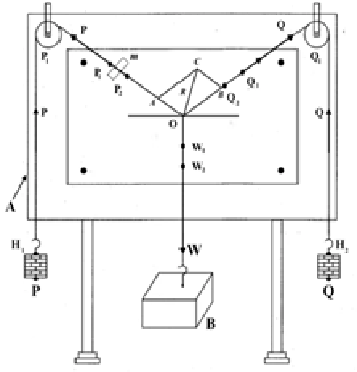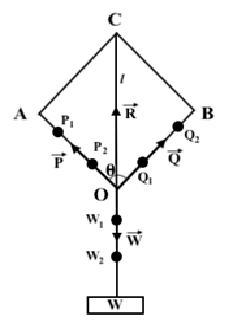Welcome to Labkafe ~ Orientallabs Retail Services Private Limited
Jul 23, 2021 / By Soumen Mondal / in Learning Experiments Physics
Aim:
To find the weight of a given body (Wooden Block) using parallelogram law of vectors.
Apparatus:
Theory :
In Fig. 5.1 we see the Gravesand’s apparatus or Parallelogram apparatus. It consists of a wooden board A fixed vertically on two pillars. There are two pulleys P and Q fitted at the same level at the top of the board. Three set of slotted weights are supplied with the apparatus which can be used to verify the parallelogram law of vectors. A thread carrying hangers for addition of slotted weights is made to pass over the pulleys so that two forces P and Q can be applied by adding weights in the hangers. By suspending the given object, whose weight is to be determined, in the middle of the thread, a third force W is applied.

Fig 5.1
If two vectors acting simultaneously on a particle are represented in magnitude and direction by the two adjacent sides of a parallelogram drawn from a point, then their resultant is completely represented in magnitude and direction by the diagonal of that parallelogram drawn from that point.
Let two vectors (P) ⃗ and (Q) ⃗ act simultaneously on a particle O at an angle θ as shown in figure 5.2. They are represented in magnitude and direction by the adjacent sides OA and OB of a parallelogram OACB drawn from a point O. Then the diagonal OC, will represent the resultant R in magnitude and direction. Mathematically we can say,
(R) ⃗= (P) ⃗ + (Q) ⃗

If a body of unknown weight W is suspended from the middle hanger and balancing weights P and Q are suspended from other two hangers then, (R) ⃗ and the three vectors (P) ⃗,(Q) ⃗ ,(W) ⃗ are in equilibrium. Under equilibrium |W| ⃗= |R| ⃗. Weight of a body is a force.
Hence, |W| ⃗ = |P| ⃗+|Q| ⃗.
Equation 1
or, 
If S is the actual weight of the body, then the percentage error in the experiment can be calculated using
Equation 2

Procedure :
Observation:
Least count of spring balance, L.C. = _______________ gm
Weight of B by spring balance, S = ________________gm
Scale factor: Let ______ cm = ___________gm
Table 5.1 Measurement of weight of given body

Calculations:

Result:
For equal weights
Weight of unknown body by observation, W: ……………………….
Weight of unknown body by calculation, W': ……………………….
For un-equal weights
Weight of unknown body by observation, W: ……………………….
Weight of unknown body by observation, W': ……………………….
Precautions :
Reference:
You may check out our blog on BEAM BALANCE
About Labkafe: Lab Equipment Manufacturer & Exporter
We are a School laboratory furniture and Lab equipment manufacturer and supplier. In laboratory furniture for school, we first design the entire laboratory room keeping in mind the requirements as per affiliation CBSE Bye-Laws. Also, we take care of the complete designing and installation of laboratory furniture.
In the lab equipment section, we have a wide range of glassware, chemicals, equipment and other lab accessories. Most of them are available for order online on our website but some of them can be procured on demand.
If you have need:-
do drop a message through chat or mail us at [email protected] or call +919007218364 and we’ll get in touch with you.
Labkafe is among the most promising laboratory supplies vendors in India. We manufacture and supply lab equipment, lab furniture, lab consumables, lab glassware, lab machines and more! Not only we manufacture lab items, we export to international resellers too. We fulfill CBSE ICSE ISC IGCSE IB State board affiliation requirements for schools by providing affiliation packages to schools. Our featured products are:
Chosen by over 1200 schools, colleges, universities, research labs, government agencies and private companies to build or renovate their laboratories, Labkafe stands as your best friend when it comes to labs. We are also a registered OEM on GeM. Our clients love us because we provide the best quality of lab products, free demos, free installation, and support for ever.
Do you wish to experience excellence too? Why not contact us today at [email protected], or call 9147163562 directly ‒ we are always available to serve. You can also use the chat button in the corner to connect to one of our representatives instantly!
Feb 16, 2023 by Biswajit Sana
Jun 03, 2022 by Swarna Karmakar